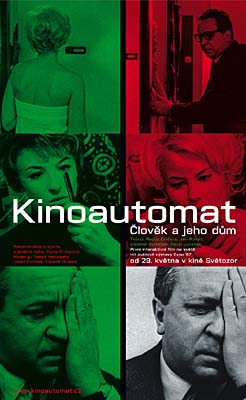- Kinoautomat
Infobox Film
name = Kinoautomat:
One Man and His House

caption =
director =Radúz Činčera Ján Roháč Vladimir Svitáček .
producer =Ladislav Kalas
writer =Pavel Juráček Radúz Činčera Miroslav Horníček Ján Rohác Vladimír Svitácek
starring =Miroslav Horníček
music =Evzed Illín
cinematography =Jaromír Sofr
editing =Miroslav Hájek
distributor =
released = 1969
runtime = 63 minutes
country = flagicon|Czechoslovakia
language = Czech
English (dubbed)
budget =
gross =
website = http://www.kinoautomat.cz/
amg_id =
imdb_id ="Kinoautomat" (1967) was the world's first interactive movie,citation | url=http://www.radio.cz/en/article/92388 | title=Groundbreaking Czechoslovak interactive film system revived 40 years later | date=14 June 2007 | publisher=
Radio Prague | accessdate=2008-08-21 ] citation | url=http://www.kinoautomat.org | title=Kinoautomat: The world's first interactive film] conceived byRadúz Činčera for the Czechoslovak Pavilion at Expo '67 inMontreal .citation | url=http://www.cbw.cz/en/kinoautomat:-interactive-cinema-comes-home/4735.html | title="Kinoautomat: Interactive cinema comes home" | publisher=Czech Business Weekly | date=28 May 2007 | accessdate=2008-08-21] At nine points during the film the action stops, and a moderator appears on stage to ask the audience to choose between two scenes; following an audience vote, the chosen scene is played.The film is a
black comedy , opening with a flash-forward to a scene in which Petr Novák (Miroslav Horníček )'s apartment is in flames. No matter what choices are made, the end result is the burning building, making the film—as Činčera intended—an effective satire of democracy.citation | url=http://www.westland.net/expo67/map-docs/cinema.htm | title=Experimental Multi-Screen Cinema | accessdate=2008-08-21 ]Expo '67 screening
The version presented in Montreal had been dubbed into English in
London , and was subtitled "One Man and his House". The production took place in a custom-built cinema, with buttons installed on each of the 127 seats, one green and one red. The lead actor (Horníček) performed the moderator's role phonetically, since he spoke no English. As the audience cast their vote, the result of each choice was displayed on the perimeter of the screen, with a numbered panel corresponding to each seat turning red or green according to the button pressed.Reception
The project was well received, with "
The New Yorker " writing: "The Kinoautomat in the Czechoslovak Pavilion is a guaranteed hit of the World Exposition, and the Czechs should build a monument to the man who conceived the idea, Radúz Činčera."citation | url=http://www.kinoautomat.cz/ | title=Kinoautomat | publisher=kinoautomat.cz | accessdate=2008-08-21 ] Initially, Hollywood studios were keen to license the technology, but under the Communist government the "Kinoautomat" concept was the property of the state, and never made the transition.In 1972, less than a year after a successful run in
Prague , the film was banned by the rulingCommunist Party of Czechoslovakia . Činčera's daughter,Alena Činčerová , suggests that "all this group of authors was so-called 'politically unconfident', they didn't like them so much and I think that was the main reason the film was put in the safe, like many other beautiful films from the so-called New Wave era, the golden era, of Czech cinematography."Interactivity
The interactive element was achieved by switching a lens cap between two synchronised projectors, each with a different cut of the film. The screenplay was written such that the two plot-lines converged at each decision point, meaning that there were only ever two possible scenes, instead of double the number after each decision point. Decades after the original screening, the film was broadcast on Czech television, with the two reels split across channels
ČT1 andČT2 , revealing the secret of limited interactivity. Činčera, who had turned down the screening initially, was later quoted insisting "they felt cheated. I was right. It was a complete disaster." [citation | url=http://www.naimark.net/writing/trips/praguetrip.html | title=Interval Trip Report | accessdate=2008-08-21 ]Choices given to the audience at decision points throughout the film include:
* Whether Mr. Novak should let in a woman, locked out of her apartment and clad only in a towel, just before his wife arrives home.
* Whether Mr. Novak should ignore a policeman flagging him down while driving.
* Whether Mr. Novak should rush into an apartment despite a tenant blocking his way.
* Whether Mr. Novak should knock out a porter blocking his way when trying to point out a small fire.creenings
* 1967, Expo '67,
Montreal ,Canada
* 1968,HemisFair '68 ,San Antonio ,United States
* 1971,Kino Světozor ,Prague ,Czechoslovakia
* 1974,Expo '74 ,Spokane ,United States
* 2006 (February),National Film Theatre ,London ,England (part of thePavel Juráček season)citation | url=http://www.bbc.co.uk/films/festivals/pavel_juracek_2006.shtml | title=Pavel Jurácek Season 2006 | publisher=bbc.co.uk | accessdate=2008-08-21]
* 2007 (May-June),Kino Světozor ,Prague ,Czech Republic References
External links
* http://www.kinoautomat.cz/index.php?lang=eng - The film's official site
* http://ftvdb.bfi.org.uk/sift/title/814398 -British Film Institute page, with cast and credits
Wikimedia Foundation. 2010.
